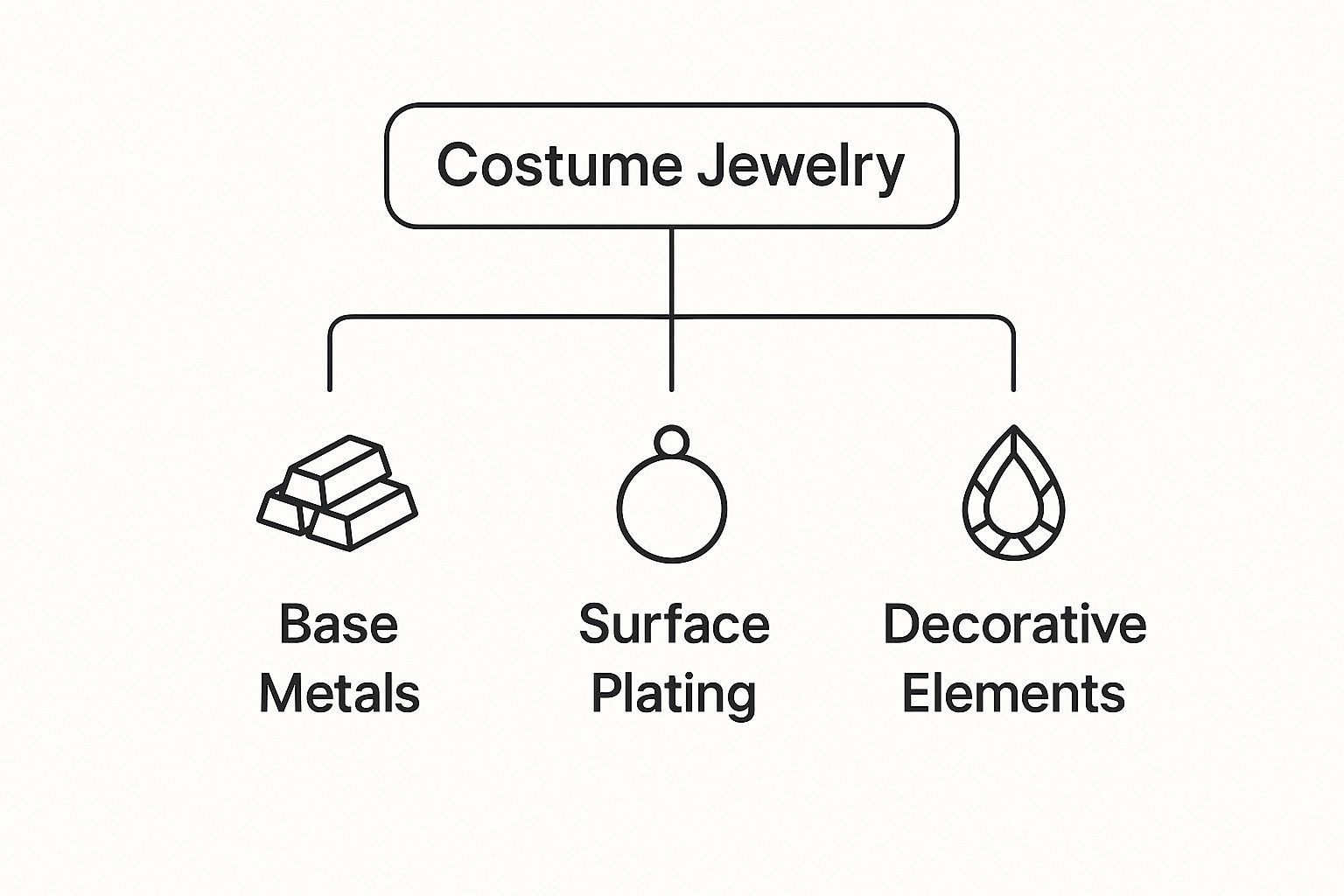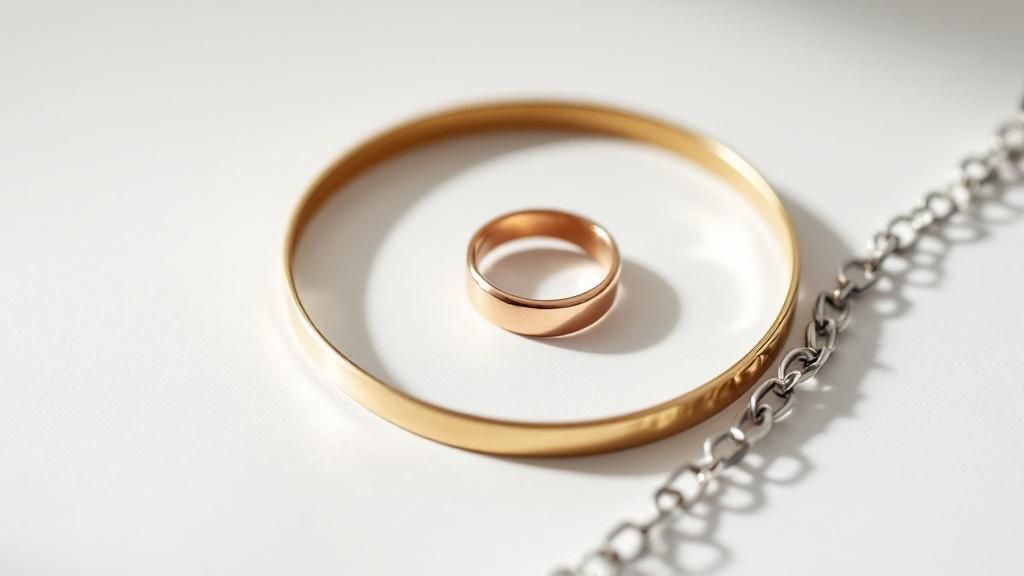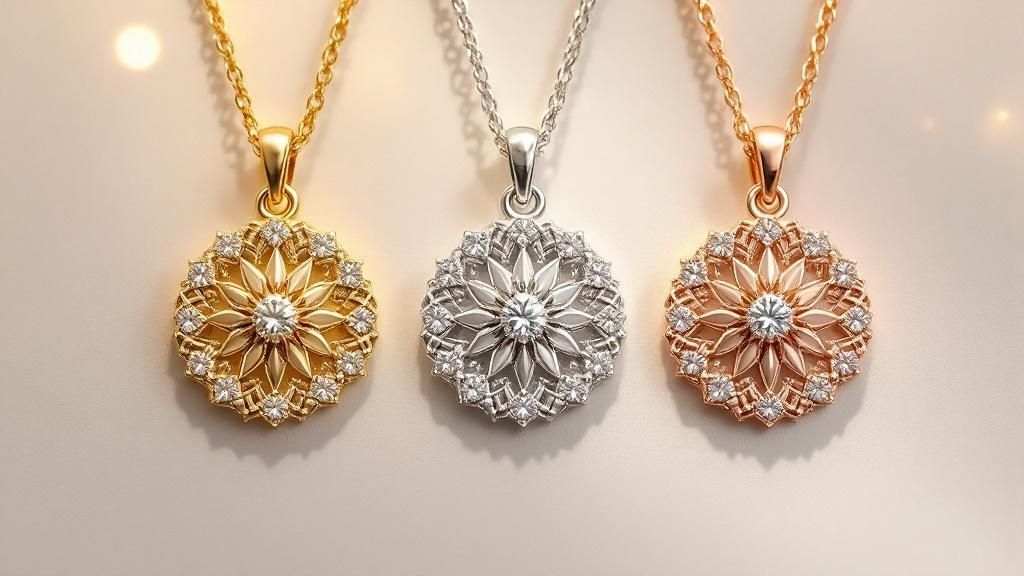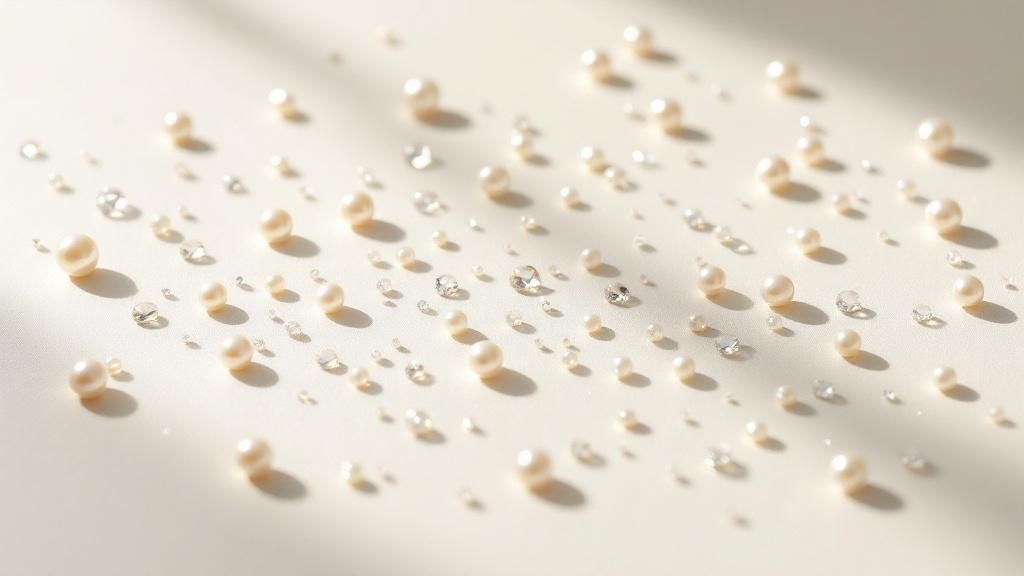What Is Costume Jewelry Made Of? A Simple Guide
- Luke Zucco
- Aug 31
- 13 min read
At its heart, costume jewelry is built from affordable base metals—think brass, copper, or zinc alloys. These provide the structure and are then coated with a very thin layer of a precious metal, like gold or silver, to give them that luxe look.
The sparkle and flash? That comes from non-precious materials. We're talking about glass, acrylic, resin, and cubic zirconia, all expertly crafted to mimic the look of real gemstones without the hefty price tag.
Your Quick Guide to Costume Jewelry Materials
Think of costume jewelry as the brilliant stunt double for its fine jewelry counterpart. It delivers the same glamour and style but gets there using clever, more accessible materials. This whole approach is what makes trendy, elaborate, and fun designs available to just about everyone.
The construction of any piece really boils down to three parts: the foundational metal, the shiny surface finish, and the decorative bits that add color and sparkle. Getting to know these components is the first step toward really appreciating your collection and becoming a much smarter shopper.
This visual guide breaks down the main material categories you'll find in costume jewelry.

As you can see, every piece starts with that base metal framework, gets its sheen from plating, and is finished off with all sorts of decorative elements.
To give you a clearer picture, here's a quick rundown of the most common materials you'll encounter.
Common Materials in Costume Jewelry at a Glance
This table shows how designers can mix and match different elements to create an endless variety of styles, from minimalist to bold.
The Building Blocks of Fashion Jewelry
The sheer versatility of these materials is what makes the world of costume jewelry so wonderfully diverse. The industry thrives on this mix of affordable metals and a vast array of synthetic stones to keep pieces lightweight, stylish, and easy on the wallet.
This allows for an incredible range of designs, from simple, sleek metal cuffs to statement necklaces absolutely dripping with faux gems.
But it’s not just about metals and sparkly stones. Designers often pull from a much wider palette to create unique pieces.
Natural Elements: Materials like wood, shell, and leather bring an earthy, often bohemian, vibe to a piece. You can see this in action with a stylish bamboo bangle where the natural material is the star.
Modern Polymers: Lucite, resin, and other plastics opened up a whole new world for jewelry makers. They allow for bold, sculptural shapes and vibrant, see-through colors that you just can't get with traditional materials.
Textiles: Don’t forget about fabric! Thread, ribbons, and other textiles are often woven into designs, adding a touch of softness, interesting texture, and a unique mixed-media feel.
The Hidden Framework of Costume Jewelry

Think of a piece of costume jewelry like a well-built house. Before you get to the beautiful facade—the sparkling stones and gleaming finish—you need a solid, dependable structure. In jewelry, that hidden framework is the base metal. It’s what gives a piece its shape, its weight, and its strength. Everything else is built upon it.
These metals are the unsung heroes of your favorite fashion pieces, chosen for specific qualities that make a design work, all while keeping things affordable. So, to really understand what costume jewelry is made of, we have to start with this foundational layer.
Brass: The Warm All-Rounder
If you've ever held a piece of costume jewelry that felt satisfyingly substantial, there's a good chance brass was involved. This alloy, made of copper and zinc, has a naturally warm, yellowish tone that makes it a fantastic stand-in for gold, even before it gets plated.
Brass is also a designer's dream because it's so workable. It can be bent, stamped, and shaped into intricate patterns without cracking or breaking. That versatility is why you see it used for everything from delicate chains to bold, statement cuffs.
Copper: The Rich and Rustic Choice
Pure copper is another go-to, especially when a designer wants to create a piece with a rustic or vintage vibe. Its signature reddish-brown color is instantly recognizable and adds a lot of character. As a metal, it's incredibly soft and malleable, which allows for really detailed craftsmanship.
Of course, copper is famous for one other thing: its tendency to react with skin. That harmless green mark it can leave behind is just a bit of oxidation, a completely natural process. Some people actually seek out the beautiful antique patina that develops over time, but most manufacturers will plate their copper pieces to prevent it.
Key Takeaway: The choice of base metal is about much more than just cost. It's a strategic decision that affects a piece's final look, its weight, and how complex the design can be. A heavier metal like brass feels more luxurious, while a lighter one like aluminum is perfect for large, comfortable earrings.
Zinc Alloys: For Designs That Demand Detail
What about those pieces with incredibly fine details, like tiny scrollwork or complex, molded shapes? For those, designers often turn to zinc alloys. The magic of these metals is their low melting point, which makes them absolutely perfect for casting.
Think of it like pouring liquid into a very elaborate ice cube tray. Zinc alloys flow into every tiny crevice of a mold, capturing sharp, precise details that would be nearly impossible to achieve by stamping or bending other metals. This process is how many of the most artistic and elaborate costume pieces are born.
Now, while these metals form the core, their surfaces are usually plated to create that polished, final look. It’s important not to confuse this affordable plating with more durable options. If you're curious about higher-quality alternatives, our guide explains in detail what gold-filled jewelry is and how it differs.
Other Notable Base Metals
While brass, copper, and zinc are the big three, you'll definitely run into a few others:
Stainless Steel: This is a powerhouse. It’s tough, resists tarnish and rust, and is a fantastic hypoallergenic option for sensitive skin. It has a cool, modern, silvery tone and is durable enough for daily wear.
Aluminum: Ever wonder how those massive, dramatic earrings are so comfortable? The secret is often aluminum. It's incredibly lightweight, corrosion-resistant, and budget-friendly.
Pewter: This is a tin-based alloy that has a soft, silvery-gray finish. It’s known for developing a beautiful, dark patina over time, making it a favorite for pieces with an antique or gothic feel.
Creating the Look of Luxury with Plating

How does a simple piece of brass suddenly look like a solid gold treasure you'd find in a high-end boutique? The secret isn't alchemy, but a clever industrial process called plating. This is the critical step that gives affordable jewelry its beautiful, convincing finish.
Think of it as a specialized, high-tech "paint job" for metal. Using chemistry or electricity, a super-thin layer of a precious metal is bonded to the surface of a less expensive base metal. This is the magic that delivers that luxe look without the solid-gold price tag.
The entire costume jewelry world hinges on this technique. Manufacturers can start with affordable, easy-to-shape metals like brass or zinc alloys. Then, as industry analysis shows, they apply a precious metal finish that perfectly mimics fine jewelry while keeping the final product accessible. It’s a smart process that opens the door to incredible creativity. You can dive deeper into these manufacturing details by checking out the costume jewelry market breakdown on SphericalInsights.com.
The Different Types of Plating Finishes
The metal used for plating completely dictates the final look, color, and feel of a piece. Each type brings its own distinct personality and characteristics to the table.
Gold Plating: This is the undisputed champion for creating a warm, classic, and expensive look. A flash of gold plating instantly elevates any base metal, giving it that rich, iconic glow.
Silver Plating: For a cool, bright shine, silver is the go-to. It gives pieces a clean, sophisticated finish that works with just about any style or color palette.
Rhodium Plating: Rhodium is the unsung hero of the jewelry world. As a member of the platinum family, it’s often plated over silver or white gold to provide a brilliant, silvery-white finish that’s incredibly tough and tarnish-resistant.
Why Plating Matters: Plating is much more than just a pretty face. It acts as a protective shield, preventing the base metal from tarnishing or causing a skin reaction.
Understanding Plating Durability
Have you ever had a favorite ring start to show a different-colored metal peeking through? That’s the plating wearing away. Since plating is an incredibly thin surface layer, its lifespan really depends on two things: its thickness and how you treat the jewelry.
Friction is the number one enemy. Rings and bracelets, which are constantly bumping and rubbing against things, will show wear far more quickly than earrings or a pendant. The chemicals in your lotion, perfume, and even your own sweat can also speed up the breakdown of that plated layer. This gradual wear and tear is just part of what costume jewelry is made of, which is why a little TLC goes a long way in keeping it looking great.
The Sparkle and Shine of Faux Gemstones

While the metal and plating form the skeleton of a piece, the faux gemstones are what give costume jewelry its soul. These brilliant additions are the heart of the design, delivering that irresistible sparkle and vibrant color that makes a piece truly pop. Think of them as masters of illusion, crafted to mimic the fiery flash of a diamond or the deep blue of a sapphire, all without the heart-stopping price tag.
Getting to know these materials is the key to truly appreciating what costume jewelry is made of. It's a fascinating world where artistry and material science collide to create beauty for everyone.
Cubic Zirconia: The Ultimate Diamond Double
If you're looking for a dead ringer for a diamond, nothing comes closer than cubic zirconia (CZ). This lab-created crystal is engineered to be optically perfect, so much so that it’s often tough for an untrained eye to spot the difference. It has an incredible fire and clarity, making it the number one choice for pieces that need a serious dose of believable bling.
But there are tells. CZ is actually denser than a diamond, meaning a CZ stone will feel heavier than a real diamond of the same size. It also ranks a bit lower on the Mohs scale of hardness, so it's more likely to get scratched up over time. Even so, its stunning look and affordability make it a cornerstone of the costume jewelry world.
Key Insight: The main difference between faux and fine gems isn't just the price—it's their origin and durability. Lab-made stones like CZ can offer a flawless appearance, while natural gems often have unique little imperfections. The materials used to imitate gemstones are chosen specifically for their ability to create maximum visual impact at a wallet-friendly price.
Rhinestones and Glass: The Classic Sparkle
Long before CZ came onto the scene, the go-to for adding flash was the humble rhinestone. Unlike cubic zirconia, a rhinestone isn't a single crystal. It’s usually just a piece of glass or crystal that's been carefully cut and then backed with a thin layer of metallic foil.
That foil backing is the secret sauce. Light streams in through the top of the stone, hits that metallic back, and bounces right back out, creating that signature bright, glittering flash. Simpler glass beads, without the foil, are also used all the time to add beautiful pops of color and a translucent quality to designs.
Acrylic and Resin: The Creative Powerhouses
For those big, bold, and artistic pieces, you can’t beat the versatility of acrylic and resin. These plastics are a designer’s dream come true, opening up a world of possibilities for shape, size, and color that other materials just can't match.
Acrylic: This material is incredibly lightweight and can be molded into almost anything you can imagine, from chunky geometric shapes to delicate, intricate flowers. It can be made clear, opaque, or even infused with glitter.
Resin: Starting as a liquid polymer that can be poured into molds, resin is perfect for embedding other decorative elements like dried flowers, gold flakes, or glitter. Once it hardens, you get a durable, glass-like solid.
Both materials give designers the freedom to create dramatic looks that would be ridiculously heavy or expensive if they were made from natural stone.
Imitation Pearls and Enamel
Rounding out the palette are materials that replicate other timeless jewelry looks. Imitation pearls, which are often just glass or plastic beads coated with a lustrous, pearlescent finish, bring that classic elegance to any piece. For a fantastic example of how faux pearls are styled to create a truly luxurious look, check out this elegant pearl bow choker necklace.
Finally, there’s enamel. This is how designers add those smooth, vibrant, and opaque fields of color you see in more intricate pieces. It's essentially powdered glass that's fused onto a metal surface with heat, creating a tough, glossy finish that's perfect for adding detailed, colorful patterns.
How to Spot Well-Made Costume Jewelry
Walking into the world of fashion jewelry can feel a little overwhelming. How do you tell the treasures from the trash? You don’t need a jeweler’s loupe to figure it out—just a few simple, hands-on tricks to separate the well-made pieces from the ones that won't last past a season.
First, trust your hands. Pick up the piece. Does it have a bit of satisfying weight to it? Quality costume jewelry often uses a solid brass base, giving it a substantial feel. If a chunky necklace or bracelet feels airy and feather-light, it’s a sign the maker probably used a cheaper alloy or even plastic.
Examine the Finish and Stone Settings
Get up close and personal with the surface. A good plating job should look like liquid metal—perfectly smooth, even, and consistent across every nook and cranny. Look for any blotches, streaks, or spots where the metal underneath is showing. The trick is to check the hidden areas, like around the clasp or on the edges, as that's where shoddy plating often reveals itself first.
Next, look at how the stones are held in place. This is a huge giveaway about the piece's overall craftsmanship.
Prong Settings: Tiny metal claws should be gripping the stone firmly. This is a classic sign of quality construction.
Bezel Settings: The stone is hugged by a thin metal rim, which is another durable and secure method.
Glue: If you can spot messy, visible globs of glue, consider it a red flag. Glued-in stones are notorious for popping out.
A well-set stone is a hallmark of quality. When manufacturers take the time to physically secure a stone with metal prongs or a bezel, it shows a greater investment in the piece's longevity compared to simply using adhesive.
Test the Functionality and Details
Finally, play with the moving parts. Work the clasp on a necklace or bracelet a few times. Does it feel sturdy? It should click shut securely without a struggle and open smoothly. Give any linked parts a gentle wiggle to make sure they feel solid, not flimsy.
Now, run your fingers over the entire piece. Quality jewelry feels smooth and finished, even on the back. Poorly made items often have rough patches or sharp edges left over from a rushed casting process. These little details make all the difference.
Of course, even the best pieces need a little TLC. You can find out more by reading our expert tips on **how to clean tarnished jewelry easily**. By using these quick checks, you’ll be able to confidently pick out beautiful accessories that are actually made to be worn and loved.
Keeping Your Favorite Pieces Looking New
Once you know what your costume jewelry is made of, you can take much better care of it and really extend its life. Protecting your favorite pieces from damage is actually pretty simple once you know the rules. It all comes down to keeping that delicate plating and those faux gemstones looking vibrant for as long as possible.
Think of your jewelry as the finishing touch to your look. It should always be the last thing you put on after you've used any lotions, hairspray, or perfumes. The chemicals in those products can be surprisingly harsh on a delicate finish. Along the same lines, it should be the first thing you take off before changing clothes or even just washing your hands.
Storage and Cleaning Essentials
How you store your jewelry is just as critical as how you wear it. Tossing everything into a single drawer is a recipe for scratches, tangles, and heartache.
Separate and Store: The best habit you can get into is keeping items in their own soft pouches or in a lined jewelry box with dividers. This simple step prevents harder stones from scratching up softer metals and acrylics.
Keep it Dry: Moisture is the enemy of most base metals, and it will speed up tarnishing like nothing else. Always store your collection in a cool, dry place—definitely not a humid bathroom.
When it's time to clean, gentleness is everything. For most pieces, a quick wipe with a soft, dry microfiber cloth is all you need to remove fingerprints and dust. Stay far away from harsh chemical cleaners, as they can easily strip off that thin plated layer.
For items with gold plating, there are specific methods you’ll want to use to avoid damage. You can find all the details in our guide on how to clean gold-plated jewelry.
Common Questions About Costume Jewelry
Alright, we've broken down what goes into making costume jewelry. Now, let's get into the nitty-gritty and tackle some of the questions I hear all the time. Getting these answers straight will help you pick out, wear, and love your pieces for years to come.
Is Costume Jewelry Safe for Sensitive Skin?
This is a big one, and the honest answer is: it really depends. Most of the time, when someone has a reaction to fashion jewelry, the culprit is nickel. It’s an incredibly common metal used in alloys to make pieces more durable, but it's also a frequent cause of skin irritation.
Don't worry, though—if you have sensitive skin, you're not out of luck. Just keep an eye out for pieces specifically labeled as "nickel-free" or "hypoallergenic." Jewelry with a stainless steel base is usually a safe bet. A thick, high-quality plating of gold or rhodium can also be a game-changer, as it puts a solid barrier between your skin and any nickel in the base metal underneath.
Quick Tip: A great little trick is to paint a thin layer of clear nail polish on the parts of the jewelry that will touch your skin. It creates a simple, invisible shield and can make all the difference.
Why Does Costume Jewelry Turn Skin Green?
Ah, the dreaded green finger. First things first: it's not harmful, just a bit annoying. This is a totally normal chemical reaction happening right on your skin.
The acids, lotions, and natural moisture on your skin can react with certain metals, especially copper. When copper oxidizes, it can leave behind that tell-tale green or even a blackish mark. Since many base metals like brass are copper alloys, it’s a pretty common occurrence. The easiest way to prevent this is to keep your jewelry dry—always take it off before you wash your hands, work out, or go for a swim.
Can You Repair Broken Costume Jewelry?
For the small stuff? Absolutely! A lot of minor fixes are easy to handle right at home.
Loose Stones: If a stone pops out, a tiny dab of jewelry glue is usually all you need to set it back in place.
Open Links: A jump ring on a chain or clasp coming open is a classic. You can gently squeeze it shut again with a small pair of pliers.
For more serious damage, like a snapped metal band or plating that's completely worn away, a repair often isn't worth the cost or effort. Because of the materials involved, most professional jewelers don't work on costume pieces. This is why gentle care from the get-go is your best strategy.
At Panther De Luxe Shop, we believe the right accessory can truly complete a look. Feel free to explore our stunning collection of curated jewelry and find your next favorite piece.

The Women 8 Ball Jacket brings a fresh touch to a legendary design, offering modern tailoring without losing its classic appeal. Perfect for casual outings or bold streetwear looks, it’s a versatile piece. Find more exclusive collections now at Stussy Jacket.